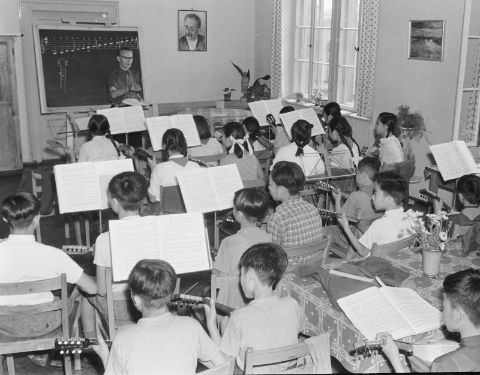Educational Exchanges: Moritzburger Kinder and Schule der Freundschaft

Music class at Maxin-Gorki-Heim, sometime between September 1956 and February 1957. Photo: Höhne, Erich/Pohl, Erich, courtesy of the Deutsche Fotothek / df_hp_0048533_017 & df_hp_0048541_042
In a recent interview with Hai Nam Nguyen, conducted in Vietnam, Le Huy Van responded to a request to comment on his time in the German Democratic Republic (GDR) by focusing instead on the framework that hosted their interaction: Echos der Bruderländer. What is an echo? He proposed that ‘echoes aren’t truly the repetition of a sound. The reflections of sound waves are already distorted, changed when they come back. What I learned in the GDR, I absorbed, understood, and then modified. I didn’t take everything as it is… An echo also gives back somehow, doesn’t it?’
Le Huy Van studied at Maxim-Gorki-Heim (MGH) near Dresden from 1956–9. He was 12 years old when he made the trip from Hanoi to Dresden by train together with 200 children and five Vietnamese teachers in order to attend the boarding school that had been created especially for this purpose. One year earlier, sixty Vietnamese children had already been sent to the nearby Käthe-Kollwitz-Heim and former students of both schools became known as the Moritzburger Kinder (Moritzbuger children).
After completing his schooling at MGH, Le Huy Van studied film in Dresden from 1959–62. He returned to North Vietnam afterwards to finish his education. When the US bombing started in 1965, Moritzburger students who finished 10th grade were again sent back to the GDR for higher education. He went to Halle’s Hochschule für industrielle Formgestaltung Halle–Burg Giebichenstein (University for Industrial Design Halle–Burg Giebichenstein) to study industrial design. After his university studies, he returned to North Vietnam and eventually became deputy director and vice rector of Hanoi University’s Industrial Fine Arts programme. He remained in close exchange with Halle colleagues and mentors, inviting them to Hanoi for educational exchanges, maintaining a relationship that continues into the present.
Large-scale educational exchanges between brother countries were marked by the active participation of various groups, including intellectuals, students, and teachers. These individuals and collectives engaged in intercultural dialogues and increased cross-border mobility, contributing to collaborative endeavours aimed at establishing educational institutions like boarding schools. Such initiatives were often tightly state-controlled. They were not only grounded in the socialist ideals of international cooperation but also intricately linked to overarching governmental strategies involving economic collaboration in infrastructure development and resource extraction. As the 1980s approached, these programmes gradually converged with a broader and globally visible policy shift towards developmental aid.
In 1982, the Schule der Freundschaft [School of friendship] opened its doors in Stassfurt, a small town just south of Magdeburg. While employing teachers from both the GDR and Mozambique, its student body was composed entirely of 900 Mozambican children, most of whom would stay and study in East Germany for at least six years. Their daily lives were dominated by a rigorous routine of learning and planned activities with few possibilities to contact their families back home. Living between the school’s dormitories during the week and their respective host families on weekends, most of the teenagers experienced little privacy. While some lasting friendships were established, many students later reported they felt an insurmountable distance between themselves and their German peers in Stassfurt. Conflicts began to arise in local night life as migrants were racially attacked, particularly for their interactions with German women. Within the material gathered here, former students Victor Celestino Muapula, Yolanda Tembe, and Francisca Raposo talk about their lives and experiences with researcher and artist Aghi, and offer excerpts from their private archives chronicling their time in the GDR.
While Mozambique and Vietnam shared a common interest in reintegrating acquired knowledge into their respective countries, this process was not without challenges. In the case of the Schule der Freundschaft, most returnees found they had no prospects in their civil-war-torn homelands and felt abandoned by the country in which they had spent their often isolated youth. From 1987 onwards, children of South West Africa People’s Organization (SWAPO) fighters from Namibia also joined the Schule der Freundschaft. But unlike students who returned to Mozambique and Vietnam, many Namibian students, after their return from the GDR years later, often struggled to reconcile with their estranged parents. In many cases, this led to them being taken in by German households who were descendants of colonial settlers in Namibia during the 1990s.
In the context of GDR-Vietnam educational exchange programmes, numerous efforts were made to modify curricula, aiming to align them with evolving societal contexts. As a result, certain initiatives persist to this day, such as those that Van contributed significantly to at the University of Design in Hanoi. This enduring legacy underscores the ongoing relevance and impact of these adapted programmes in the contemporary educational landscape.